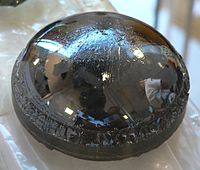
Photo from wikipedia
Abstract The degradation of organic dye molecules through the photocatalysis process has been explored widely by researchers. There have been many attempts to create photocatalyst material that meets the qualities… Click to show full abstract
Abstract The degradation of organic dye molecules through the photocatalysis process has been explored widely by researchers. There have been many attempts to create photocatalyst material that meets the qualities required, one of which is the synthesis of TiO2 nanocomposite. In this study, modifications on TiO2 were made to enhance its photocatalytic activity, namely by exposing the (001) crystal facet of TiO2 and integrating graphene oxide in the catalyst to form TiO2/GO nanocomposite. From the characterizations carried out in this study, TiO2/GO nanocomposite with exposed (001) crystal facet has been successfully synthesized. The exposure percentage of the (001) facet is observed at the value of 13.47% and 15.54% for two TiO2/GO samples with a different titania precursor source. Furthermore, the photocatalytic performance test shows that this percentage of exposure, along with graphene oxide in the nanocomposite, does affect the photodegradation percentage of methylene blue. The photocatalyst samples worked well under irradiation of visible light, which has successfully degraded methylene blue solution by up to 51.30% for the reaction of 1 h. This improvement in the photodegradation process is presumed to result from the exposed (001) facet that provides more reactivity to generate radical species and the graphene oxide that assists charge separation well.
Journal Title: Journal of Physics and Chemistry of Solids
Year Published: 2022
Link to full text (if available)
Share on Social Media: Sign Up to like & get
recommendations!